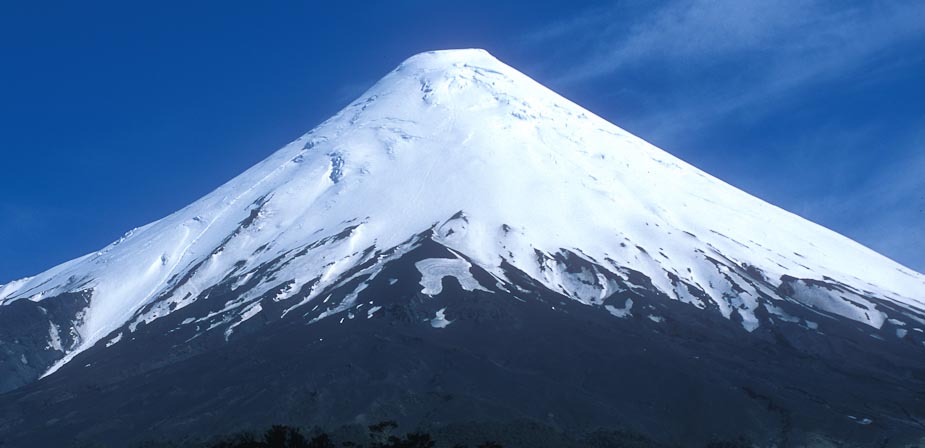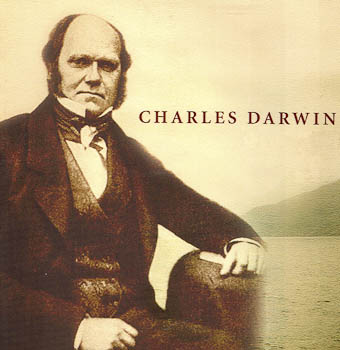 WHY TRAVEL IN DARWIN'S FOOTSTEPS?
WHY TRAVEL IN DARWIN'S FOOTSTEPS?
Charles Darwin's theory of evolution—the multi- branched "tree of life"—was such a dazzling leap in the history of science that it tends to over- shadow the epic voyage of discovery that inspired it. In 1831, the H.M.S. Beagle, under the com- mand of Captain Robert Fitzroy, embarked from England to complete the survey and mapping of the South American coastline. No one guessed that Darwin, the callow 22-year old hired to be the expedition's naturalist, would be both a gifted, intensely curious observer of nature and an ex- traordinarily intuitive geologist. We now view the Beagle's five-year expedition as the most impor- tant scientific voyage of all time.
Committed to a life in science, Darwin spent the two decades following the Beagle's return to England immersed in his expedition journals and notebooks, studying his specimen collections, conducting experiments, and corresponding with fellow scientists. Darwin's Beagle narrative suggests that it was his geologic discoveries in Patagonia—the relationships between the fossil and living forms of both marine and terrestrial animals—that would prove pivotal in developing his theory of natural selection. The marine fossils he found in the high Andes, well inland from either coast, supported his growing belief in the Earth's great antiquity and that violent cataclys- mic upheaval occurred repeatedly. Darwin finally published On the Origin of Species in 1859—the now-famous book detailing the biological mecha- nisms responsible for the diversity of life on Earth, for variation within species, and for the
geographical distribution of species and varieties. Darwin's theory of evolution was an unequivocal and science-based rebuttal of creationism—a stand that placed him squarely at the epicenter of Victorian scientific and religious debate, the reverberations of which continue to this day.
Charles Darwin was, in many ways, the first conservationist—believing that humans represent but one tiny twig on an enormous and luxuriantly branching tree of life. Desk-bound and ailing dur- ing his later years, it was his memories of Patago- nia that most sustained him.What would Darwin think of the challenges facing Patagonia today? Our first expedition traced Darwin's explorations along the Atlantic coastline of Patagonian Argentina and the fjords of Tierra del Fuego. Our In Darwin's Footsteps (Part II) begins along the Strait of Magellan and heads north to the high Andes and the Pacific coastline of Patagonian Chile, Chiloé Island, and the volcano country in Aconcagua's shadow.
IN DARWIN’S FOOTSTEPS (PART II):
CHILEAN PATAGONIA AND THE HIGH
ANDES, INCLUDING TORRES DEL PAINE
NATIONAL PARK, VOLCÁN OSORNO,
CHILOE ISLAND, AND DARWIN’S CROSS -
ANDEAN JOURNEY TO MENDOZA
December 2-19, 2011
Carol & Carlos Passera, Dr. Yan Linhart, Sarah Drummond, and Marilyn Hailbronner
We rejoin our intrepid explorers, Captain Fitzroy
and Charles Darwin, as the H.M.S. Beagle leaves
the Strait of Magellan and heads north along
the fjord-etched coastline of Chilean Patagonia.
The province of Magallanes is truly a land of
extremes—immense glaciers, ice-choked fjords
and turquoise-blue lakes, towering granite spires,
snow-covered volcanoes, alpine grasslands, windswept
steppes, emerald-green beech forests, and
mist-drenched temperate rainforests. The region
encompasses the realm of the Andean condor and
is home to a fascinating bestiary of unusual
species—-the guanaco, mouse opossum, Darwin’s
rhea, austral parakeet, Chilean flamingo, blacknecked
swan, and many others.
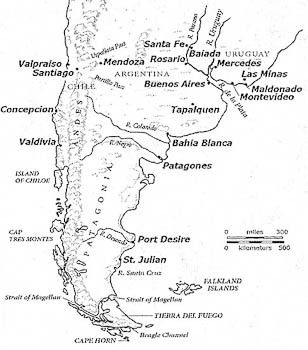
Flying south from Santiago to Puntas Arenas,
located on the Strait of Magellan, we visit two
historic sites—Puerto Hambre (Port Famine) and
Fuerte Bulnes (Fort Bulnes). Port Famine was the
ill-fated colony founded by Spanish conqueror
Pedro Sarmiento de Gamboa in 1584 to prevent
British pirates from crossing the Strait and attacking
Spanish settlements along the Pacific coast.
More than two centuries later, in 1843, Chile established
Fuerte Bulnes, later replacing it with
Punta Arenas-—finally securing claim to the Strait
of Magellan. As Fitzroy and Darwin did in 1834,
we’ visit the grave of Pringle Stokes, the
Beagle’s captain during the first South American
survey. In 1826, in the midst of surveying the
western shores of Tierra del Fuego, Captain
Stokes took his life when the hardships of his
command became unendurable. On that first trip,
Stokes’ subordinate officer, Robert Fitzroy, took
over as the Beagle’s captain—-leading ultimately
to Fitzroy’s command of the second survey expedition,
the participation of Charles Darwin as the
expedition’s naturalist, and the repatriation of the
three Fuegian hostages taken to England as part of
Fitzroy’s misguided desire to bring the "civilizing"
influence of christianity to Tierra del Fuego.
 We’ll visit Cueva del Milodón, where the fossil
bones of giant ground sloths were recovered.
Darwin’s fascination with giant Pleistocene-age
mammals (megafauna) began early in the Beagle
voyage, when he discovered fossil bones of at
least nine extinct species in northern Argentina,
including those of a slightly smaller sloth,
Mylodon darwinii. We’ll spend several days
exploring Torres del Paine National Park,
regarded by many as the most dramatic mountain
scenery in the world. From our base at Hosteria
Lago Grey, with its view of the Grey Glacier and
the ebony-capped Cuernos del Paine, we’ll hike
and experience this wilderness landscape much as
Darwin might have done. Torres del Paine is one
of the best places to observe and photograph
guanacos. We should see the season’s first baby
guanacos (chulengos) as we explore Paine’s lush
alpine highlands. Our visit coincides with the
peak of the bloom, the luminescent reds of Chilean
firebush and Magellanic fushia contributing
to the firestorm of color we can expect. We’ll
explore elegant, old-growth forests of southern
beech, listening for the distinctive tapping of a
giant Magellanic woodpecker or the arrival of a
noisy flock of bronze-green austral parakeets.
We’ll scan the swiftest rivers for torrent ducks,
whitewater afficionados, and watch quiet back
eddies for Andean ruddy ducks, flying steamerducks,
or ashy-headed geese. In Torres del Paine’s
secluded valleys, we may even catch a glimpse of
a Patagonian gray fox or a rare huemul deer. We’ll visit Cueva del Milodón, where the fossil
bones of giant ground sloths were recovered.
Darwin’s fascination with giant Pleistocene-age
mammals (megafauna) began early in the Beagle
voyage, when he discovered fossil bones of at
least nine extinct species in northern Argentina,
including those of a slightly smaller sloth,
Mylodon darwinii. We’ll spend several days
exploring Torres del Paine National Park,
regarded by many as the most dramatic mountain
scenery in the world. From our base at Hosteria
Lago Grey, with its view of the Grey Glacier and
the ebony-capped Cuernos del Paine, we’ll hike
and experience this wilderness landscape much as
Darwin might have done. Torres del Paine is one
of the best places to observe and photograph
guanacos. We should see the season’s first baby
guanacos (chulengos) as we explore Paine’s lush
alpine highlands. Our visit coincides with the
peak of the bloom, the luminescent reds of Chilean
firebush and Magellanic fushia contributing
to the firestorm of color we can expect. We’ll
explore elegant, old-growth forests of southern
beech, listening for the distinctive tapping of a
giant Magellanic woodpecker or the arrival of a
noisy flock of bronze-green austral parakeets.
We’ll scan the swiftest rivers for torrent ducks,
whitewater afficionados, and watch quiet back
eddies for Andean ruddy ducks, flying steamerducks,
or ashy-headed geese. In Torres del Paine’s
secluded valleys, we may even catch a glimpse of
a Patagonian gray fox or a rare huemul deer.
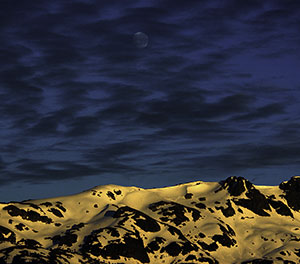 The snow-covered volcanoes of the Andes appear
like islands in a cloud-capped sea as we fly north
up the coast, to the bustling Pacific port city of
Puerto Montt. The entire country of Chile forms
part of the Pacific "Rim of Fire" and geologists
have identified some 2,085 volcanoes, 55 of
which are considered active. We’ll arrive in
Puerto Montt with ample time to wander the city’s
colorful harbor, watch fishing boats off-load their
catch, and enjoy the famous seafood and craft
markets at Angelmó. Traveling northeast to the
Chilean Lake District-—volcano country—-we are
reminded that Darwin watched from the Beagle’s
decks as the night sky lit up with the spectacular,
molten-red eruption of Fuji-like Volcán Osorno.
Darwin later learned that hundreds of miles to the
north, Volcán Aconcagua and Volcán Coseguina
(which he guessed to be 2,700 miles north of
Aconcagua) erupted violently on that same night
and that the earthquake associated with the
Coseguina eruption was felt 1,000 miles away.
The coincidence of these eruptions inspired
Darwin to theorize that certain volcanically active
zones must be interconnected at depth. Our own
explorations here will emphasize the scenic,
geologic, and biological diversity that so intrigued
Darwin during his visit-—the algae-green Río
Petrohué and its lava-bench waterfalls, turquoise-hued
Lago Llanquihue, the Valdivian temperate
rainforest at Lahuen Ñadi National Park, and the
magical landscapes along the lower slopes of
Volcán Osorno. We’ll hike through a rainforest
preserve dominated by alerce (Fitzroya cupressoides),
a Chilean and Argentinian endemic evergreen
related to the redwood and giant sequoia.
Thickets of native bamboo (Chusquea) form a
distinctive understory in these ancient forests,
attracting unusual birds such the chucao tapaculo,
huet-huet, and green-back firecrown. The snow-covered volcanoes of the Andes appear
like islands in a cloud-capped sea as we fly north
up the coast, to the bustling Pacific port city of
Puerto Montt. The entire country of Chile forms
part of the Pacific "Rim of Fire" and geologists
have identified some 2,085 volcanoes, 55 of
which are considered active. We’ll arrive in
Puerto Montt with ample time to wander the city’s
colorful harbor, watch fishing boats off-load their
catch, and enjoy the famous seafood and craft
markets at Angelmó. Traveling northeast to the
Chilean Lake District-—volcano country—-we are
reminded that Darwin watched from the Beagle’s
decks as the night sky lit up with the spectacular,
molten-red eruption of Fuji-like Volcán Osorno.
Darwin later learned that hundreds of miles to the
north, Volcán Aconcagua and Volcán Coseguina
(which he guessed to be 2,700 miles north of
Aconcagua) erupted violently on that same night
and that the earthquake associated with the
Coseguina eruption was felt 1,000 miles away.
The coincidence of these eruptions inspired
Darwin to theorize that certain volcanically active
zones must be interconnected at depth. Our own
explorations here will emphasize the scenic,
geologic, and biological diversity that so intrigued
Darwin during his visit-—the algae-green Río
Petrohué and its lava-bench waterfalls, turquoise-hued
Lago Llanquihue, the Valdivian temperate
rainforest at Lahuen Ñadi National Park, and the
magical landscapes along the lower slopes of
Volcán Osorno. We’ll hike through a rainforest
preserve dominated by alerce (Fitzroya cupressoides),
a Chilean and Argentinian endemic evergreen
related to the redwood and giant sequoia.
Thickets of native bamboo (Chusquea) form a
distinctive understory in these ancient forests,
attracting unusual birds such the chucao tapaculo,
huet-huet, and green-back firecrown.
 Darwin was especially intrigued by his visit to the
Chiloé archipelago—-where even the indigenous
creation mythology originates in the fiery crucible
of the island’s volcanoes. Chiloé’s Isla Grande,
the second largest island in Latin America, is
surrounded by several smaller groups of islands,
many of which are joined at low tide. To reach
Isla Grande, we take a ferry across Chuchao
Channel, which separates mainland Chile from
Chiloé. The archipelago and its people, the
Chilotes, present a culturally distinct experience,
with architectural styles, music, dance, and craft
traditions clearly distinguishable from those of
their fellow Chileans. Darwin noted that the
geographic isolation of Chiloé had given rise to
several unique plants and animals. We’ll sample
many of Chiloé’s highlights, focusing on Parque
Tepuhueico, where we’ll explore lush Valdivian
rainforests in hopes of spotting a Darwin’s fox,
tiny pudú deer, or one of the shy, tree-dwelling
marsupials. The coastal dunes and rocky beaches
provide opportunities to see colonies of both
Magellanic and Humboldt penguins in close
proximity, rock cormorants, kelp geese, sea lions,
sea otters, and many other species. Darwin was especially intrigued by his visit to the
Chiloé archipelago—-where even the indigenous
creation mythology originates in the fiery crucible
of the island’s volcanoes. Chiloé’s Isla Grande,
the second largest island in Latin America, is
surrounded by several smaller groups of islands,
many of which are joined at low tide. To reach
Isla Grande, we take a ferry across Chuchao
Channel, which separates mainland Chile from
Chiloé. The archipelago and its people, the
Chilotes, present a culturally distinct experience,
with architectural styles, music, dance, and craft
traditions clearly distinguishable from those of
their fellow Chileans. Darwin noted that the
geographic isolation of Chiloé had given rise to
several unique plants and animals. We’ll sample
many of Chiloé’s highlights, focusing on Parque
Tepuhueico, where we’ll explore lush Valdivian
rainforests in hopes of spotting a Darwin’s fox,
tiny pudú deer, or one of the shy, tree-dwelling
marsupials. The coastal dunes and rocky beaches
provide opportunities to see colonies of both
Magellanic and Humboldt penguins in close
proximity, rock cormorants, kelp geese, sea lions,
sea otters, and many other species.
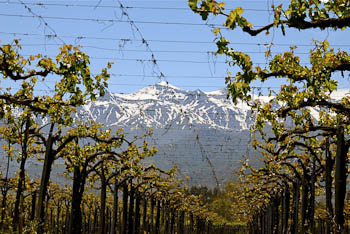 Of Darwin’s many horseback expeditions into the
South American backcountry, none were as
geologically fruitful for him as his cross-Andean
traverse from Santiago, Chile to Mendoza,
Argentina—all within the mighty shadow of
Volcán Aconcagua, South America’s highest peak.
Though our journey won’t require ten mules to
transport our provisions, we’ll see many of the
places Darwin did as he crossed the great
Cordillera—spectacular multi-hued ridges of volcanic
and sedimentary strata, Volcán Tupungato,
Puente del Incas (a natural bridge) and its associated
hot springs, the wildflower-dotted puna
(alpine) along Uspallata Pass, and the climber’s
trail to Volcán Aconcagua—before dropping down
into the world-famous vineyard country of beautiful
Mendoza. We’ll celebrate another grand adventure
In Darwin’s Footsteps with a glass of Malbec held high in Darwin’s honor! Of Darwin’s many horseback expeditions into the
South American backcountry, none were as
geologically fruitful for him as his cross-Andean
traverse from Santiago, Chile to Mendoza,
Argentina—all within the mighty shadow of
Volcán Aconcagua, South America’s highest peak.
Though our journey won’t require ten mules to
transport our provisions, we’ll see many of the
places Darwin did as he crossed the great
Cordillera—spectacular multi-hued ridges of volcanic
and sedimentary strata, Volcán Tupungato,
Puente del Incas (a natural bridge) and its associated
hot springs, the wildflower-dotted puna
(alpine) along Uspallata Pass, and the climber’s
trail to Volcán Aconcagua—before dropping down
into the world-famous vineyard country of beautiful
Mendoza. We’ll celebrate another grand adventure
In Darwin’s Footsteps with a glass of Malbec held high in Darwin’s honor!
Price: $7,200 (includes a $1,000 deposit)
Group Size: 18
Trip Rating: 2
Price Includes: 17 days/16 nights, including all hotel/airport transfers, all ground transportation, all lodging, 4-day cruise in Tierra del Fuego (Mare Australis), all meals, services of three naturalist leaders, local guides/lecturers, all national park and museum entrance fees, and all gratuities.
Does not include roundtrip airfare (12/2-3 & 12/18-19) to Santiago from your point of departure, internal flights/airport taxes (≈$585), or trip insurance. Trip cost is based on double occupancy; single supplement is $1,525.
|
